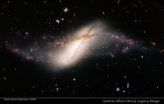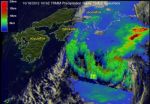(Press-News.org) Noise can be distracting, especially to a person trying to concentrate on a difficult task. Studying annoying noises helps architects design better building environments and policy makers choose effective noise regulations. To better understand how short noise bursts affect humans' mental state, researchers from the University of Nebraska – Lincoln played quarter-second-long white noise clips to test subjects as they worked on arithmetic problems. The researchers noticed a slight general trend toward lower performance when louder noises were played, and also identified sound level ranges that caused participants to report significant levels of annoyance. The researchers report their findings at the 164th meeting of the Acoustical Society of America (ASA), held Oct. 22 – 26 in Kansas City, Missouri.
The motivation for the research came from NASA's low-boom supersonic aircraft program. Sonic booms, generated when aircraft traveling faster than the speed of sound leave cones of compressed air in their wake, are loud and potentially unnerving. In 1964, when the Federal Aviation Administration starting flying supersonic jets regularly over Oklahoma City as part of a test called Operation Bongo, many citizens filed complaints and damage claims. NASA is now working on developing aircraft that create softer booms, but is it not clear at what volume regular booms, as might be created by commercial supersonic aircraft flying over land, would be acceptable.
Lily Wang, an architectural acoustician at the University of Nebraska – Lincoln, worked with her graduate student Christopher Ainley to design an experiment to test how noise bursts affect the performance and perceptions of test subjects. Previous studies had looked at loud noises of more than 80 decibels (dB), louder than an average vacuum cleaner, and found a clear effect on subjects' ability to solve arithmetic problems. Wang and her team reduced the volume to see if they could find a threshold value under which the noise would not significantly affect the participants. Twenty-seven test subjects were asked to memorize 6-digit numbers, and then, when shown a 4-digit number, the subjects had to subtract the second number from the first number in their heads and type the answer on a keyboard. Occasionally the researchers would play a quarter-second burst of noise while the second number appeared on the screen.
The researchers tested noise bursts in the range of approximately 50 – 80 dBA. The dBA unit indicates that the volume was measured with a filter used to approximate the human ear's response to sound. The noise levels were comparable to about the sound level on a suburban street corner at the low end, to vacuum-cleaner loud at the high end. While the test subjects solved a lower percentage of problems correctly when interrupted with a noise at the louder end of the spectrum, the difference was not enough to be statistically significant. However, there was a significant difference in the levels of annoyance that the participants reported when quizzed afterwards about their perceptions of the noise environment. "The test subjects sort of adjusted to the quieter booms, but the louder ones remained jolting," says Wang. "This suggests that the acceptable noise from sonic booms should not be higher than 70 dBA once it gets inside the house."
The researchers' lab did not have the necessary equipment to mimic the very low-frequency component of the noise produced by sonic booms, Wang notes, but the work helped to quantify the effect of the short duration characteristic of the booms. As a next step, the researchers hope to study perceptions of the rattling component of noise that is often associated with supersonic jets passing overhead.
INFORMATION:
MORE INFORMATION ABOUT THE 164th ASA MEETING
The Kansas City Marriott Downtown Hotel is located at 200 West 12th Street, Kansas City, Missouri, 64105. The hotel main numbers are: 816-421-6800; fax: 816-855-4418.
USEFUL LINKS
Main meeting website: http://acousticalsociety.org/meetings/kansas_city
Meeting Abstract Database: http://asa.aip.org/asasearch.html
Hotel site: https://resweb.passkey.com/Resweb.do?mode=welcome_ei_new&eventID=8120158
WORLD WIDE PRESS ROOM
ASA's World Wide Press Room contains additional tips about newsworthy stories and with lay-language papers, which are 300-1200 word summaries of presentations written by scientists for a general audience and accompanied by photos, audio, and video.
PRESS REGISTRATION
ASA will grant free registration to credentialed full-time journalists and professional freelance journalists working on assignment for major news outlets. If you are a reporter and would like to attend, contact Charles E. Blue (cblue@aip.org, 301-209-3091), who can also help with setting up interviews and obtaining images, sound clips, or background information.
This news release was prepared for the Acoustical Society of America (ASA) by the American Institute of Physics (AIP).
ABOUT THE ACOUSTICAL SOCIETY OF AMERICA
The Acoustical Society of America (ASA) is the premier international scientific society in acoustics devoted to the science and technology of sound. Its 7,000 members worldwide represent a broad spectrum of the study of acoustics. ASA publications include The Journal of the Acoustical Society of America (the world's leading journal on acoustics), Acoustics Today magazine, ECHOES newsletter, books, and standards on acoustics. The Society also holds two major scientific meetings each year. For more information about ASA, visit our website at http://www.acousticalsociety.org.
END
Miss hitting the "sweet spot" on a baseball bat and the resulting vibrations can zing your hands. Bat companies have tried for decades to reduce these painful shocks with limited success. But Daniel Russell, a professor in the graduate program in acoustics at Pennsylvania State University in University Park, has figured out that bat vibrations between 600 and 700 hertz (Hz) cause the most pain and that specifically tuned vibration absorbers are the best at combatting the sting. He will present the results of his damping technique comparisons at the 164th meeting of the ...
Earthquakes sway buildings, buckle terrain, and rumble – both audibly and in infrasound, frequencies below the threshold of human hearing. New computer modeling by a team of researchers indicates that most of the low-frequency infrasound comes from an unexpected source: the actual "pumping" of the Earth's surface. The researchers confirmed their models by studying data from an actual earthquake.
"It's basically like a loudspeaker," said Stephen Arrowsmith, a researcher with the Geophysics Group at Los Alamos National Laboratory in Santa Fe, N.M., who presents his team's ...
VIDEO:
Einstein predicted gravity waves in his general theory of relativity, but to date these ripples in the fabric of space-time have never been observed. Now a scientific research technique called...
Click here for more information.
A pioneering technology capable of atomic-level precision is now being developed to detect what so far has remained imperceptible: gravitational waves or ripples in space-time caused by cataclysmic events including even the Big Bang itself.
A ...
Tropical Storm Maria is moving away from Japan and strong wind shear is pushing its rainfall east of the storm's center, according to NASA satellite imagery.
On Oct. 18 at 0845 UTC (4:45 a.m. EDT), NASA's Tropical Rainfall Measuring Mission (TRMM) satellite saw that rain associated with Tropical Storm Maria was limited to the east of the storm's center. Rainfall was also light to moderate, falling at a rate between .78 to 1.57 inches/20 to 40 mm per hour. There were no areas of heavy rain remaining in the tropical cyclone. The low-level center of the storm is now exposed ...
When the lamp is shattered,
The light in the dust lies dead.
When the cloud is scattered,
The rainbow's glory is shed.
These words, which open Shelley's poem "When the Lamp is Shattered," employ visions of nature to symbolize life in decay and rebirth. It's as if he had somehow foreseen the creation of this new Gemini Legacy image, and penned a caption for it. What Gemini has captured is nothing short of poetry in motion: the colorful and dramatic tale of a life-and-death struggle between two galaxies interacting. All the action appears in a single frame, with the ...
Heavy rainfall returned to Typhoon Prapiroon for a brief time on Oct. 18 when NASA's TRMM satellite passed overhead. Prapiroon is battling strong wind shear and is expected to transition into an extra-tropical storm in the next day.
NASA's Tropical Rainfall Measuring Mission (TRMM) satellite captured rainfall data on Prapiroon twice on Oct. 18 when it passed overhead. The first orbit was at 0845UTC and the second at 1019 UTC. TRMM's Microwave Imager (TMI) and Precipitation Radar (PR) data show that rain associated with Prapiroon was falling at a rate of over 75mm/hour ...
Hurricane Rafael is no longer a tropical cyclone. The storm merged with a cold front on Oct. 18, but not before NASA's Terra satellite captured an image of the storm when it was in its last day as a hurricane.
The Moderate Resolution Imaging Spectrometer (MODIS) instrument aboard NASA's Terra captured a visible image of Hurricane Rafael in the North Atlantic on Oct. 17 at 1440 UTC (10:40 a.m. EDT). Although Rafael was far from land, its northwestern fringe clouds were brushing Nova Scotia, Canada.
By 5 p.m. EDT on Oct. 17, Rafael had become extra-tropical, meaning that ...
In a new perspective piece being published Online First tonight in Annals of Internal Medicine, a physician recalls lessons learned from treating patients affected by the 2002 outbreak of Exophiala (Wangiella) dermatitidis meningitis or arthritis related to contaminated, injectable coticosteroids prepared from a compounding pharmacy.
According to the author, the lessons he learned in 2002 are applicable to the current outbreak. He warns that compounding of preservative-free corticosteroids requires meticulous sterility to ensure lack of fungal contamination. Without ...
NEW ORLEANS – Ashley Thomas was born with spina bifida and uses a wheelchair. She also holds a position on the U.S. national para-kayak team, and founded and runs a successful nonprofit organization called "Bridge II Sports." The North Carolina-based organization develops programs that provide opportunities for children and adults with physical disabilities to play team and individual sports. Ms. Thomas will be speaking about her experiences at the American Academy of Pediatrics (AAP) National Conference & Exhibition (NCE) in New Orleans at 11:15 a.m., Friday, Oct. 19 in ...
NEW ORLEANS – An abstract presented Friday, Oct. 19, at the American Academy of Pediatrics (AAP) National Conference and Exhibition in New Orleans highlights the risky behavior of child pedestrians who are struck by cars – including darting into the street, crossing in the middle of the block, and crossing while using an electronic device.
For the abstract, "Risky Behaviors of Pediatric Pedestrians Who are Struck by Motor Vehicles," researchers collected data on all pedestrians who were injured by a motor vehicle and presented to a Level I trauma center in New York City ...




